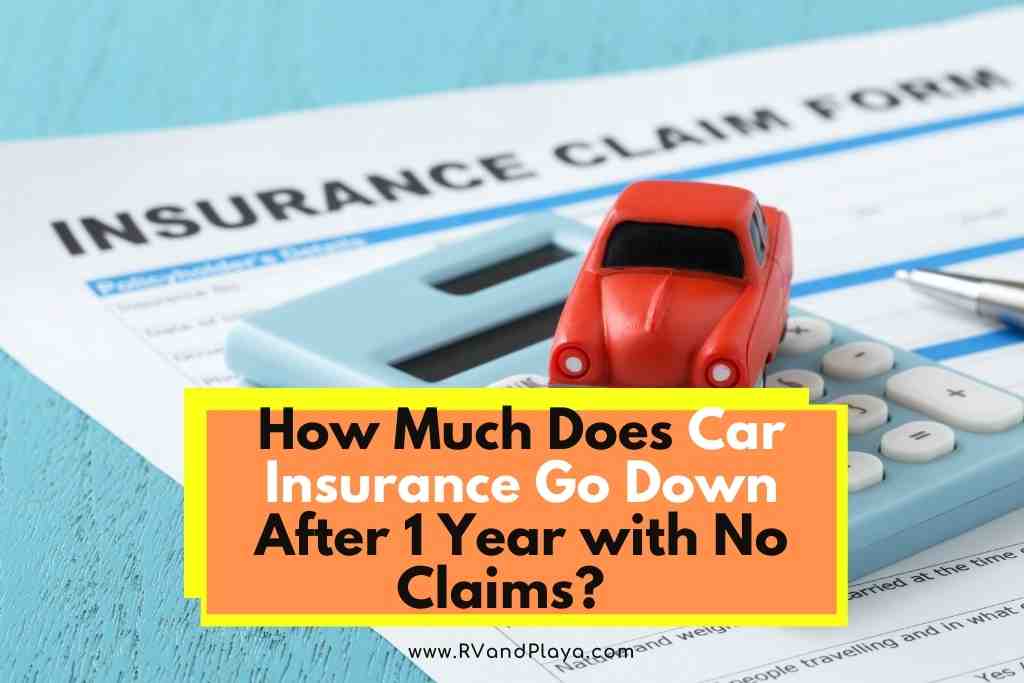Wondering how much your car insurance goes down after a year with no claims? Well, you’ve found the right place.
You may well be surprised by just how much you can save by keeping safe on the road and having a claim-free year.
On average car insurance go down by approx. 30% after 1 year with no claims. However, this number will differ based on various factors that will affect the final cost of your car insurance which included:
#1 Driving History
#2 Driver Age
#3 Location
#4 Driving Experience
#5 Insurance History
#6 Gender
#7 Marital Status.
#8 Vehicle and Ownership Status
#9 Credit Score
#10 Claims History
From your vehicle to your marital status, how many aspects of your life play a role is overwhelming.
Table of Contents
How Much Does Car Insurance Go Down After 1 Year with No Claims?
Since so many factors affect the total cost of your car insurance, we can’t give you an exact answer as to how a one-year no claims bonus decreases the cost.
However, you can expect to experience the following discounts, as long as nothing else changes:
- After 1 Year No Claims — 30% discount
- After 2 Years — 40% discount
- After 3 Years — 50% discount
- After 4 Years — 60% discount
- After 5 Years — 65% discount
To give you a clearer understanding of just how much you could save, take a look at these rates offered by popular providers across the USA:
| Car Insurance Provider | With No Claims | 6 Months After a Claim |
|---|---|---|
| Nationwide | $673 | $1,087 |
| GEICO | $638 | $998 |
| Progressive | $802 | $1,386 |
| State Farm | $656 | $808 |
| Allstate | $994 | $1,508 |
| Farmers | $762 | $1,113 |
As you can tell, you save quite a lot of money by not making claims!
Read also: When Does Gap Insurance Not Pay (9 True Reasons)
What Factors Affect The Cost of Car Insurance?
#1 Driving History
Insurers see your past driving years as an accurate record of your future driving performance. If you have lots of traffic violations or tickets, your insurance cost rises.
#2 Driver Age
This is a big one! Age, especially if you’re a young driver, is one of the most considered factors.
Teenagers pay the most expensive insurance, and 50-year-olds pay the most affordable — and the difference can be well over $5,500 per annum!
The younger you are, the riskier and potentially more expensive you are for your insurer. But the good news is that once you hit 20, age becomes less important.
When you reach 25, your age is even less impactful.
#3 Location
Car insurance providers consider both your state and your zip code.
It’s regulated at the state level. So, each insurer must comply with the state regulations.
For instance, in Michigan, you must have PIP coverage, making car insurance more expensive than states (like Ohio) where you don’t need the extra cover.
The price by zip code helps providers adjust their costs with the environmental factors of each area. For example, zip codes with a higher driver number mean more expensive insurance.
Similarly, areas prone to vandalism, floods, or wildfires inflate the price.
#4 Driving Experience
The more experience you have as a driver, the less likely you are to make a mistake. In other words, you aren’t as risky as drivers with fewer years of experience.
#5 Insurance History
New drivers aside, a lack of constant car insurance indicates higher risk. In the eyes of the insurer, having a license but not insurance means you might have been driving uninsured.
The difference between those with five years of coverage and those with no previous coverage is around $200 per year. We know this doesn’t seem like much, but it soon adds up!
Read also: Does Esurance Have Gap Insurance (Lease Coverage & Quotes)
#6 Gender
Gender is typically only considered when dealing with young drivers.
Statistics show that male teens pay around $750 more every year for car insurance premiums than females of the same age.
Yes, we know this seems unfair. However, insurers estimate that male teens are more likely to take risks than females.
#7 Marital Status
Granted, marital status is one of the less relevant factors. However, it still plays a role.
According to historical data, married drivers share the driving, resulting in fewer individual claims.
With that said, it’s worth noting that the difference in rates for widowed, single, married, and divorced drivers is tiny.
#8 Vehicle and Ownership Status
A shiny new sports car will always cost more to insure than an old Golf. Basically, the higher the cost to replace your vehicle, the more your monthly insurance costs.
As for ownership, premiums vary depending on whether you lease, finance, or own the vehicle.
#9 Credit Score
Unbeknownst to most, credit scores play a huge role in car insurers’ rates — drivers with lower credit file more claims than those with better scores. Not to mention the claims are usually more expensive!
The difference between the insurance rates of those with the highest and lowest credit scores is quite a bit over $1,500 every single year.
#10 Claims History
Finally, we come to the factor you’ve all been waiting for — claims history.
Every insurance provider looks at a lengthy claims history and hears alarm bells ringing. Your claims history includes all the claims you file and those you’ve had filed against you.
If your insurer has to pay out, your rate shoots up.
We’ll talk about this in more detail in the next section.
How to Protect Your No Claims Bonus
Amazingly, there is a foolproof way to safeguard your no-claims bonus! However, you do have to pay additional fees on top of your car insurance to do so.
Once you start paying, your no claims status is protected, even after you make a claim.
With that said, it’s worth noting that paying for protection doesn’t completely shield you from a more significant premium when you renew your car insurance policy.
Premiums are affected by the number of years without claims and the number of claims made.
What Happens If You Make Two Claims in a Year with a No Claims Protection?
It entirely depends on your insurance provider! Some insurers don’t change your no claims protection after two claims in a year. However, others might reduce it.
That’s something worth keeping in mind when deciding whether or not the protection plan is worth it.
The Bottom Line
After your first year of no claims, you can expect some wonderfully high discounts!
Here are some of my favorite services, products, and Stores
I created this resource page to easily list recommended services, products, and companies that I use and/or those I know are valuable.
This way you can quickly find great products and services all in one place. You can save thousands of dollars all from one page!
There are affiliate links, so if you do decide to use any of them, I´ll earn a small commission. But in all honesty, these are the exact what I use and recommend to everyone, even my own family.
+ Products & Services
+ Earn More
+ Save Thousands of Dollars
+ Live More
References
https://www.thezebra.com/auto-insurance/driver/other-factors/
https://www.uswitch.com/car-insurance/no-claims-bonus/
Recent Posts
Does Your Auto Insurance Cover a Travel Trailer? [Updated Rules]
When RV accidents happen, they can cause serious injuries, damages, and in some cases, death. These are things that someone on vacation does not want to face. However, neither do insurance companies....
If you have ever totaled an RV you know the headache it can be when dealing with insurance. But some people aren’t even aware of the option to buy back their RV after it has been deemed totaled by...


